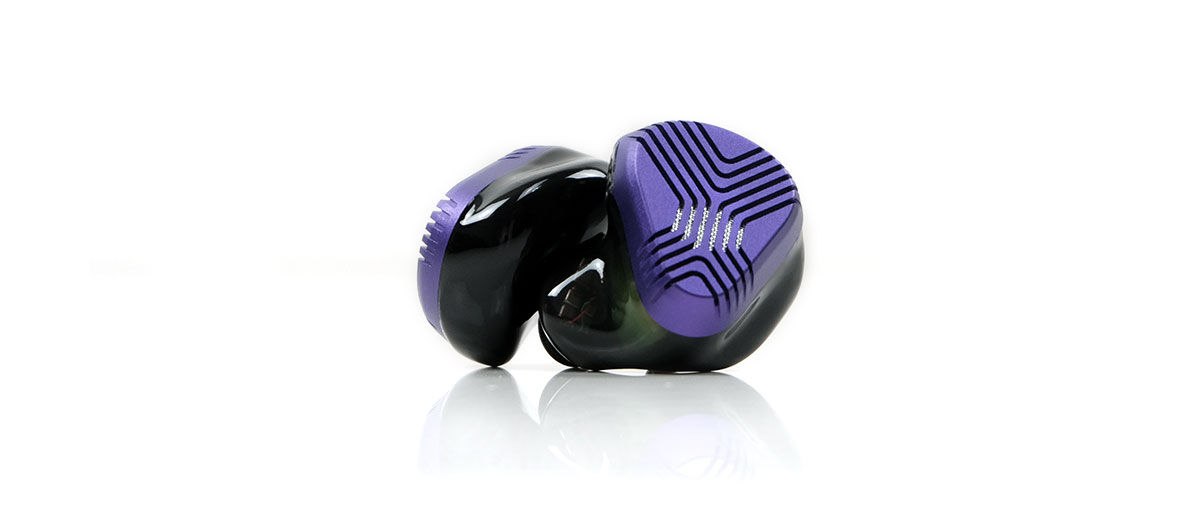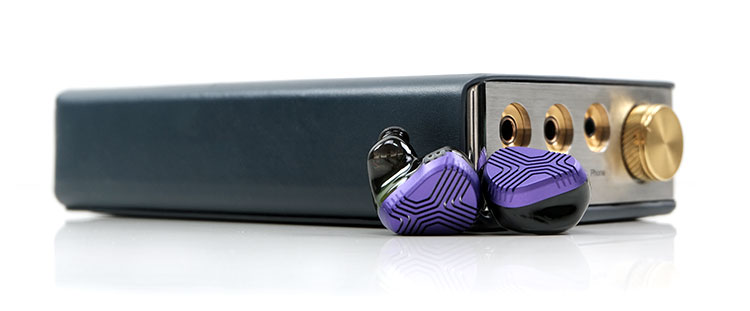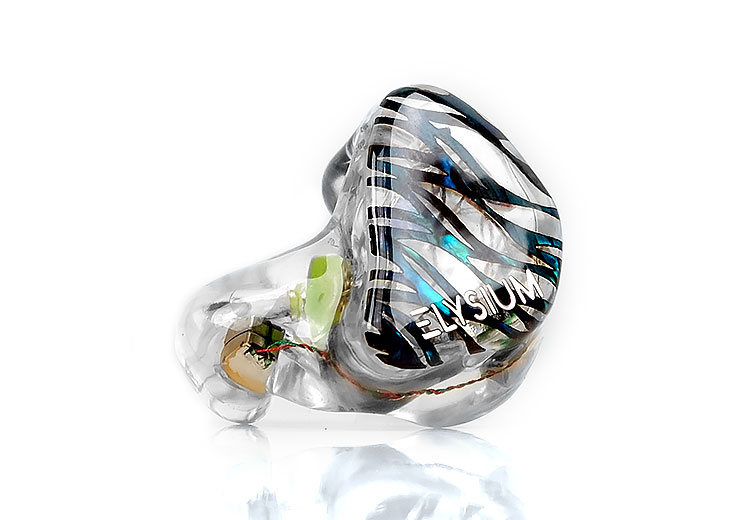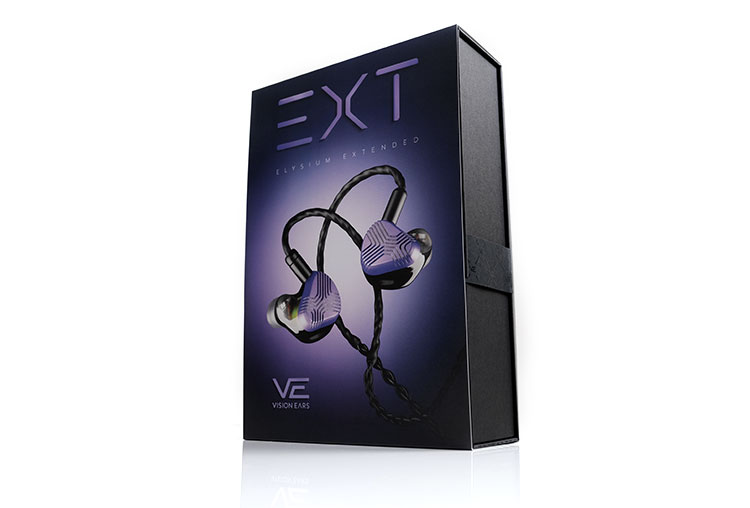Synergy
Efficiency
The EXT is rated at 10Ω and 108.5db SPL and compared to the original Elysium it is indeed more sensitive and slightly easier to drive.
However, it is not so sensitive to pick up on background hiss from DAP and amplifier outputs, nor is it subject to any noticeable impedance skew from higher than average output impedance ratings.
With our selected comparison models, the EXT does need more volume compared to the Odin despite it being rated the same 108dB SPL. The gap between the 64 Audio U18s was slightly less pronounced using a low gain setting and 4.4mm balanced outputs from the likes of the LP P6 and the latest RS6 DAP from HiBy.
Pairings
You want to get as much textured detail as you can out of those two excellent EXT dynamic drivers. At the same time, ensuring there is enough clarity and dynamic range so that lighter passages and nuanced treble spatial cues from the stats drivers remain pure and articulate.
Balance
A good example of this balance was the Sony 1Z versus the Luxury & Precision P6 Pro. Both produce some excellent body and weight when paired with the EXT but the Sony was warmer and far less revealing through the bass and mids. The Sony treble also sounded a little digital which spoiled the EXT electrostatic driver performance for me.
On the other hand, the P6 Pro sounded more spacious with a blacker background. It also got a better grip on the dynamic range when paired with the EXT.
It is a slightly more reference sound compared to the Sony granted, but the amount of detail in the texture of each note combined with the realism was spectacular with the EXT. By far one of my favorite pairings.
R2R
Continuing the R2R theme, I would pick the N6ii/R01 combo over the HiBY RS6 for the EXT pairing. The R01 fills the soundstage a bit better sounding grander and slightly more dynamic.
It has a thinner vocal and treble sound compared to the RS6 so if your fixation is on smooth euphonic vocal performance then the RS6 will have an edge.
However, that brighter treble and more holographic presentation from the R01 worked very nicely with the EXT e-stat drivers bringing them to the fore and creating some nice contrast to the low-end dynamic driver warmth.
Also, the base to mids separation and layering on the EXT was more pronounced with the R01 which I tended to gravitate to more if I am not focusing purely on the vocal performance.
Delta-Sigma
For purely delta-sigma, the EXT paired ok with the Lotoo PAW Touch Gold Touch. Something about its reference sound signature didn’t bring out the most engaging sound with the EXT. The far superior pairing was the DX300 MAX.
This was an incredibly vivid, detailed, and expansive pairing, especially going 4.4mm balanced where the energy and additional headroom were palatable. Of the DAPs tested I would aim for either the P6 Pro or the DX300 MAX as the most suitable pairings with the EXT.
Select Comparisons
Vision Ears Elysium
€2500 (Custom version) €2050 (Universal Version)
The Elysium was VE’s first electrostatic monitor and until this year their flagship monitor. It is still their flagship custom IEM since both the EXT and the soon-to-be-reviewed Phonix are universal creations.
Technical
The EXT has a 6-driver count compared to just 4 inside the Elysium with a single dynamic driver for the lows, a dynamic for the mids, and 4 for the highs. The Elysium uses a pair of dual 1st gen Sonion electrostatic drivers for the highs.
The EXT swaps out the single BA Elysium used for the bass response and instead opts for a much stronger 9.2mm single dynamic driver with an Al-Mg Alloy diaphragm and Rare Earth N52 Neodymium Magnets.
The 6.2mm DD for the mids is the same size but has a different tuning and implementation with the 2nd gen HALC acoustic and side tuning chambers. It also has an additional double N52 Neodymium Magnet to lock down further the potential for distortion.
Beyond that, the quad electrostatic configuration for the highs now uses a more efficient 2nd gen Sonion transformer and driver system. Combined with the new dynamic driver implementation, the EXT is now more sensitive at 108.5dB SPL as opposed to 105dB whilst minimizing any associated distortion from that increased efficiency.
Design
The Elysium we have here is the custom version as opposed to the universal so a bit difficult to make a direct comparison. We do know that for the EXT and the way it is implemented, Vision Ears couldn’t make a custom version of it that sounded optimal.
Suffice it to say that whilst I regard the EXT to be possibly one of the best universal vented dynamic driver models around for passive isolation, the perfect fit of the custom Elysium will perform better. Ideally, your mold should also be an exact duplicate of your ear and should feel more comfortable than the EXT.
However, it is bigger and it has to be to get the seal and fit just right. Kudos then to VE for managing to shrink the EXT down to that size and still get an excellent level of comfort and isolation.
As for aesthetics, it is a preference thing. I think the Elysium design is pretty striking but for some, the intricate X design and CNC-milled aluminum design of the EXT might hold greater value and possibly be more resistant to knocks.
Both cables are the same 28AWG 8-wire SPC, the only change is the finishing and the additional 4.4mm Pentaconn adaptor included with the EXT which is quite handy.
Performance
The most obvious difference is the quantity and extension of the enhanced bass performance of the new 9.2mm driver inside the EXT compared to the previous woofer BA used by the Elysium. It’s huge, no denying that. It’s a full-on meaty dynamic driver warmer timbral tone with excellent depth and power, producing a planted and visceral performance.
The BA of the Elysium always performed above my expectations for low-end BA drivers but it sounds very ‘supportive’ here in deference to its star dynamic driver, that 6.2mm mids driver.
However, dig a little deeper and there are several other more nuanced changes in the EXT that tweak some different aspects beyond the bass compared to the Elysium.
Subtle changes to the midrange bump on the EXT with more focus on the 1-2k region as opposed to the upper mids. It sounds a little more balanced, something which I suspect was needed to ensure that a stronger bass line does not dominate.
Another tweak is the 7-8k narrow band bump on the Elysium which gives it that trademark shimmer on higher pitching percussion. It’s a bit flatter on the EXT with a change-up instead in the extension and presence of the upper treble.
In doing so, you get a little more body on the EXT treble without any loss of that beautiful electrostatic tonal purity. It also sounds roomier, and more expansive with improved depth and headroom.
I can’t knock the Elysium for those magical mids though. They are as stunning as ever, especially with the custom version. Using the Azla tips on the EXT you get a bit more harmonic dissonance on the upper mids which I am not a fan of but the SpinFits bring the EXT closer to that Elysium midrange beauty.
Empire Ears Odin
$3399
The Odin was our Top Gear Award winner for 2020 and is still Empire Ear’s flagship monitor today. It initially came out as a universal design but you can now get it as a custom monitor.
Technical
The Odin is also a hybrid monitor but with 3 flavors of drivers, dynamic, BA, and electrostatic as opposed to the EXT’s dynamic and electrostatic mix. It uses a dual Weapon IX+ woofer for the lows which contrasts to the single 9.2mm dynamic driver inside the EXT.
The big difference is the mids with the Odin using 5 balanced armatures with 2 dual-driver units for the lower mids and the mids and a single BA driver for the mid-highs. VE keeps it simpler with a single 6.2mm dynamic driver for the EXT mids.
Both use quad electrostatic drivers for the highs and ultra-highs though EE has not stated specifically if these are Sonion Gen 2 drivers that the EXT uses. I presume both are 2nd gen.
The crossover system used by the EXT is a much simpler 3-way crossover compared to the far more complex 8-way synX crossover inside the Odin. Given the more complex BA split in the mids of the Odin that is not surprising.
Both come armed to the teeth with additional proprietary tech including a 2nd Gen HALC Acoustics chamber with a side tuning chamber and Rare Earth N52 Neodymium Magnets for the EXT.
For the Odin, aside from their Weapon IX+ dynamic driver technology, we also have an EIVEC transformer designed to link up with the 8-way synX crossover and an Anti-Resonance Compound or ARC for a more resonance-free performance from the internal drivers.
Design
Both monitors I have here are quasi-custom-designed universal monitors. That means that each company has brought its custom design know-how to the table to produce a universal design that should give most users a maximum degree of comfort and isolation.
And they do that quite well actually albeit through slightly different methods. The EXT design for me is much more aggressive in trying to perfect that 2nd bend ear canal reach and also sits a lot flusher to the concha. It is aided by a smaller curvier design also.
The Odin has more of a classic quasi-custom shape and is larger but with a longer plate-to-tip extension so it feels like it is going deeper into your ear even when I suspect both are close enough to each other.
The venting port system is quite different also with the Odin using their tri-port venting on the side of the shells and the EXT using that more discreet mesh grill behind the aluminum faceplate.
The EXT might have a slight edge in isolation but I suspect the excellent Azla tips that come with them is a factor. The Final E tips are generally very good and maybe comfier but they do not seal as brilliantly as the Azla tips. Using these tips with the Odin brought the seal very close indeed.
Cable
I have to give the edge to the Odin for the supplied PW Audio-produced Stormbreaker cable which is a modified 4-conductor variable 26AWG/24AWG OCC copper Litz 1960s variant. On its own, it’s $1299 which is no small change and worthy of purchase in its own right
The 8-wire 28AWG SPC cable from VE is good, comfortable, and easy to work with. I also have a slight preference for the braided finish compared to the Stormbreaker’s twisted design. However, it is a slightly more resistant wire choice with that smaller gauge so not quite the same dynamic range compared to the Stormbreaker performance.
Performance
A detail monster, (Odin) versus a mood setter (EXT) is probably the shortest summary I can give them. Odin’s precision-controlled battery of BAs in the mids and the energetic upper-mids imaging give it a very different presentation to the smoother, denser dynamic timbre of the EXT.
Both dynamic drivers extend amazingly well on the low end with similar levels of power so neither compromises on lower pitching instrumental fundamentals. However, the dip in the lower mids and the 1-3k rise on the Odin is more aggressive which thins out the lower mids presence and, in turn, enhances the bass-to-mids separation.
The EXT has a gentler drop from 50Hz down to 1k bringing with it a bit more warmth and body into the lower mids and offering less tonal contrast. Guitar work is more organic and natural sounding on the EXT compared to the detailed, precise, and quick-sounding performance from the Odin.
Vocal imaging is much further forward on the Odin with that pronounced 1-3k bump, it takes no prisoners, and for a vocal lover, I just lap it up. However, Odin’s upper mids need a delicate pairing balance. The Final E tips keep them vivid but can sometimes give them a harder edge, whereas SpinFits smooth it out more for me.
The EXT mids are not as forward but have a bit more warmth and balance with a relatively smaller 1-2k bump and less upper-mids push. The vocals are more relaxing, retaining that lovely organic feel from the Elysium but sit further back compared to the Odin.
I felt the EXT top-end stats delivered a bit more subtle headroom compared to Odin which is relatively neutral in terms of upper-treble presence and it has to be to get the synergy just right with those forward upper mids.
64 Audio U18s
The U18s sits behind the Fourte as one of 64 Audio’s top universal monitors. This is an IEM we reviewed earlier this year and you can read in more detail about it here.
$2999
Technical
A very different internal makeup with the 18 balanced armature driver U18s versus the hybrid 6 driver dynamic and electrostatic mix of the EXT. Not a shred of BA timbre versus an all-BA timbre monitor.
The U18s’s driver grouping consists of 8 drivers for the lows, 8 for the mids, 1 for the mid-highs, and a tia driver for the highs. This is all pieced together via an integrated 4-way electronic passive crossover.
tia stands for tubeless with the driver using an open balanced BA design. With the diaphragm free of obstruction, the contention is that a lot of the vibrations and resonances you get with closed or tubed designs will be gone.
The EXT’s dual dynamic driver setup is also treated for a low resonance performance but via Rare Earth N52 Rare Earth N52 Neodymium Magnets for both the 9.2mm low-end driver and the 6.2mm mids driver.
This is a tubed design but VE also has its unique approach to acoustics with that 2nd Gen HALC and additional side tuning chamber for further mids refinement.
The other key difference is the apex or Air Pressure Exchange technology inside the U18s. This is a system that reduces the level of pneumatic pressure that can lead to hearing damage.
It also can tweak the tuning of the system with 3 filters that can open up the performance or double down on the bass with variable isolation levels.
The EXT’s dynamic driver system has its own cleverly integrated venting system for the dynamic driver inside the faceplate though nothing quite as specific or as tweakable as apex.
Design
One of the best all-aluminum designs versus one of the most innovative quasi-custom universal designs? Very different approaches and the U18s might seem more sedate in its aesthetic but the machining on that plate, much like the EXT is exquisite.
There is a lovely contrast here between the two designs. You get the aggressive anodized purple X grill design of the EXT and the silvery sparkle of the underlying aluminum acoustic mesh and the natural formations aesthetic of the U18s dark and complex CNC milled inlay U18s design.
You also get durable, robust, and solid versus lithe, low-profile, and that quasi-custom fit, and here I think the EXT has an advantage. I can’t knock the strength of the CNC aerospace-grade aluminum billet used by 64 Audio for the U18s but its shaping is a little more rigid than the curvy EXT. That has advantages for the EXT.
The EXT, combined with that unusual right-angle nozzle offers a snug fit in the ear and isolates better also with the supplied Azla tips and flush fit in the concha.
That may seem surprising because you would expect a ventless BA to isolate better but you have to remember that the apex system also introduces a level of venting to the U18s.
Switching to the Azla tips with the U18s does close the isolation gap considerably between these two monitors so I would encourage you to grab a few for the U18s if you like their performance.
Cable
Our U18s reviewed tock cable does have a similar SPC wire but I prefer the darker finish of the EXT stock version with its matching black jacket and barrels as well s the tighter braiding.
Some might prefer the softer looser braiding of the 64 Audio ‘Silver” cable and its silvery pop from the transparent jacket though the thicker strand count does mean a heavier memory coating. Both handle very similarly with no memory retention and very low microphonics during use.
Performance
I find these two to complement each other rather than compete. The U18s is a reference tool for studio specialists with a very coherent BA timbre that is subtle and controlled. Whereas the EXT is more joyful, heavier on the power, and with a more organic tone designed to enjoy rather than purely monitor.
EXT lovers might find the U18s balanced and careful tuning to be a bit boring whereas the U18s users might find the more bombastic heavy-hitting EXT to be too excitable.
What is certain, there is much more bass weight from the EXT dynamic driver, a bit more density, and a solid bass fundamental. The U18s BA drivers can get a lift from the m20 apex module but still sound light and pillowy in comparison.
The U18 lower mids pick up a bit of mid-bass warmth but overall, it’s a shade further back compared to its 1-4k region which is an area the U18s does very well with. Vocals are not as rounded or as fulsome as the EXT but they can sound cleaner and clearer.
The EXT carries more warmth into the lower mids sounding more physical also. Instruments have a stronger dynamic texture but can sound a shade slower with more decay compared to the U18s detailed, articulate but light-bodied equivalent. Vocals are not quite as forward sounding on the EXT but sound more natural and smoother to the ear.
The highs on the U18s are smooth and controlled rather than energetic with a distinct but coherent BA timbre. It has less shimmer and upper treble extension but it does sound very detailed nevertheless.
The EXT shines in this depart with that pure electrostatic tone that sounds effortless and pure. There is also a bit more energy and headroom staging-wise.
Our Verdict
The EXT is a cracking update on the Elysium but importantly, it is an energetic and engaging tuning that should create a clear distinction between these two world-class performers.
I had my reservations that a universal version of this configuration would cut it but the innovative shaping and diminutive design excel and come very close to what a custom design can offer in terms of isolation.
Clever, creative, and most importantly, a very comfortable fit for me. Elysium fans should stick with the SpinFit tips though for that smoother sound.
I can still see vocal lovers cling dearly to their Elysium but for those who wanted bombastic lows and a much bigger soundstage whilst still retaining the magic of a dynamic driver timbre for the mids then the EXT should answer that and then some.
Vision Ears EXT Specifications
- 1 x 9.2mm Dynamic Driver
- 1 x 6 mm Dynamic Driver
- 4 x Electrostatic Tweeter
- Impedance: 10Ω @ 1KHz
- Sensitivity 1mW: 108.5 dB SPL @ 1KHz (100mV)







